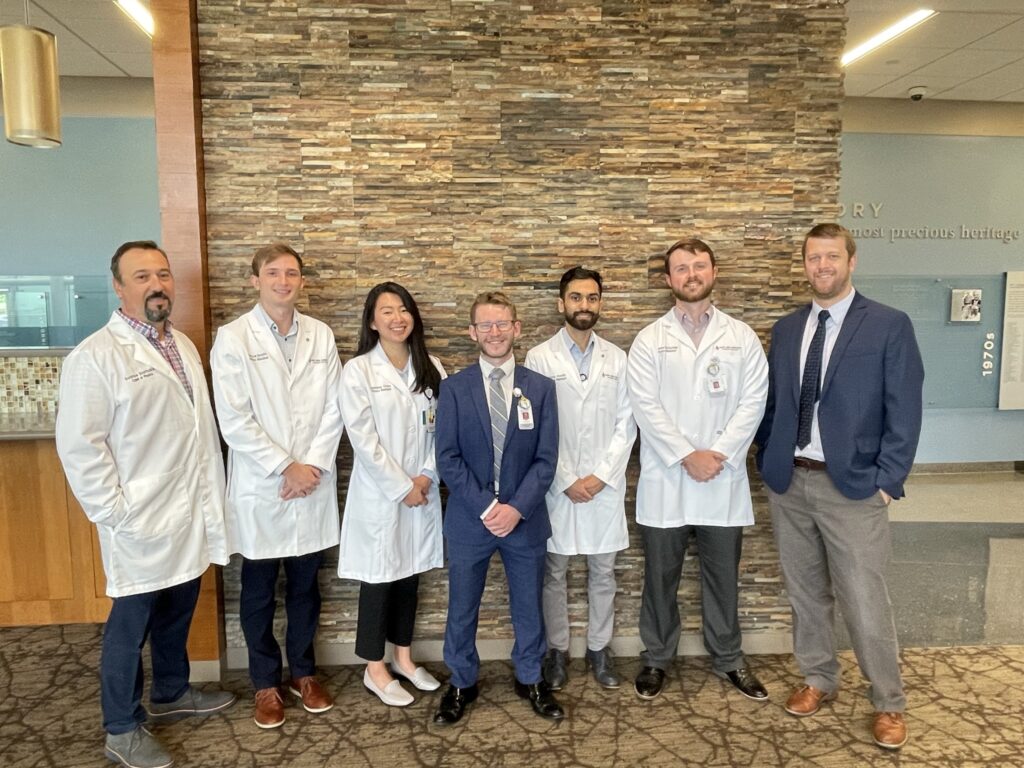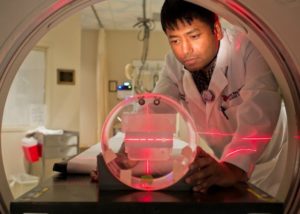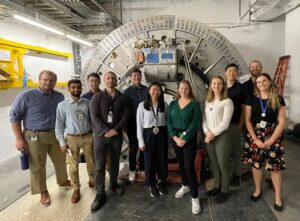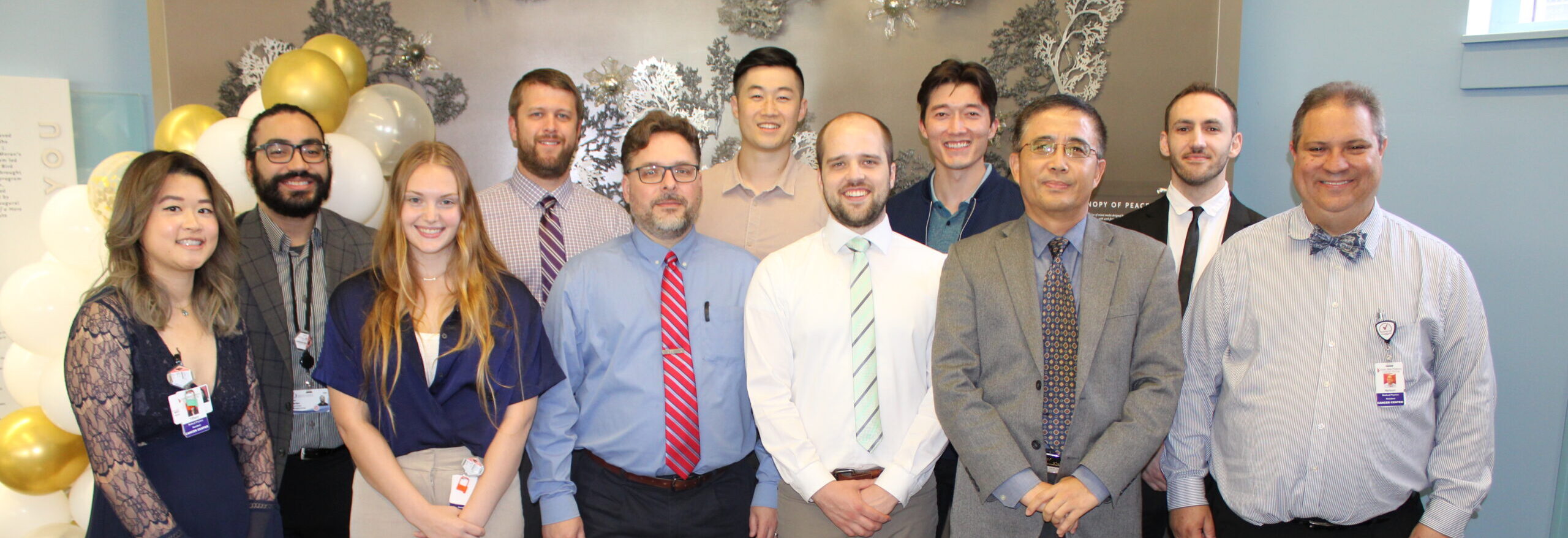Residency Training Program
Using a collaborative approach, Mary Bird Perkins formed a medical physics consortium with multiple affiliate sites, including Willis-Knighton Cancer Center in Shreveport, LA and the University of Mississippi Medical Center in Jackson, MS. This has allowed for the expansion of residency training opportunities and resources. In conjunction with its affiliates, Mary Bird Perkins now has one of the largest and most comprehensive radiation oncology physics residency training programs in the United States.
For more information on our residency program, click the below items:

Program Objectives
The CAMPEP-accredited Mary Bird Perkins Cancer Center (MBPCC) Therapeutic Physics Residency Training Program provides training in clinical radiation oncology physics in preparation for American Board of Radiology (ABR) certification and independent practice in clinical medical physics in radiation oncology. The program covers the majority of topics found in AAPM Report 249, through a combination of supervised training and independent work. After successful completion of the program, the resident will have covered the essential curricula for the board certification examination for radiation oncology physics.
Program Consortium / Hub and Spoke Model
MBPCC has reached agreements with two regional cancer centers to serve as partner programs in the residency program, Willis-Knighton Cancer Center (Shreveport, LA) and the University of Mississippi Medical Center (Jackson, MS). These affiliate sites were chosen based on their interest in the program, and having sufficient clinical staff and resources to effectively train residents. Each site has a local program director who is also a member of the Program Steering Committee. This type of collaborative endeavor enables us to train additional residents and provide exposure to more special procedures than are available at any one site.
Medical physicists and administration at all locations have shown a great deal of support in developing these partnerships. The partner sites began resident training in July 2011, and each partner site currently has two to three residents in the program. Details of the Consortium Affiliate Sites may be found at:
Organizational Structure
The program is located within the Department of Physics, Radiation Oncology Services at MBPCC and is headed by the Residency Program Director, Dr. Garrett Pitcher.
The direction and content of the program is governed by the Residency Program Steering Committee, which consists of:
- MBPCC Residency Consortium Program Director and Committee Chair – Garrett Pitcher, Ph.D.
- MBPCC Chief of Physics – Sotiri Stathakis, Ph.D.
- MBPCC Director of Clinical Physics – Dan Neck, M.S.
- UMMC Affiliate Program Director – Chunli “Claus” Yang, Ph.D.
- WKCC Affiliate Program Director – Joe Dugas. Ph.D.
- Director of the Medical and Health Physics Program at LSU – Wayne Newhauser, Ph.D.
- An ABR-certified radiation oncologist
- An MDCB-certified medical dosimetrist
All clinical operations of the program are administered by board-certified or board-eligible staff (medical physicists and dosimetrists).
Historical Development
MBPCC and its Physics Department have been actively involved in Medical Physics education and training for over 25 years through the training of Medical Physics graduate students at LSU. In 2004, MBPCC entered into a formal agreement with LSU for an integrated academic-community cancer center model for Medical Physics. This agreement was integral in the 2006 CAMPEP accreditation of the M.S. in Medical Physics and Health Physics Program and the 2011 CAMPEP accreditation of the Ph.D. in Physics with specialization in Medical Physics within the LSU Department of Physics and Astronomy. Development of a CAMPEP-accredited Medical Physics Residency Program was the next planned step in the training of clinical medical physicists.
In 2004, MBPCC administration granted approval for the creation of a Therapeutic Physics Residency Training Program. Over the next four years, departmental faculty and staff were added to a level adequate to establish and sustain the program. Program development began in March 2009, under the supervision of Program Director Dr. John P. Gibbons, Jr. The first resident began the Program on July 1, 2009 and completed residency training on August 31, 2011.
In October 2014, Dr. Jonas Fontenot succeeded Dr. Gibbons, serving Program Director for until December, 2021. At that time, Dr. Garrett Pitcher was appointed as Program Director, while Dr. Fontenot continues to serve as Chief Executive Officer of MBPCC.
In 2021, the program received re-accredited by CAMPEP through December 2026.
Mary Bird Perkins and all affiliate residency training sites participate in the medical physics matching program administered by National Matching Services, Inc. Therefore, all interested applicants must register and apply through the MedPhys Match Program. All applications should be submitted to the Mary Bird Perkins CC Consortium Residency (Code: 12611). Applications submitted to this program will be eligible for consideration at all three consortium locations. Because each affiliate of the Consortium has its own code in the MedPhys Match and independently selects their resident(s), applicants must indicate in their match rank order list each individual affiliate to which they are applying to be considered for a position at that institution. Site codes for Consortium Affiliates are as follows: Mary Bird Perkins Cancer Center, Baton Rouge, LA (Code: 12611), Willis-Knighton Cancer Center, Shreveport, LA (Code: 19311), and the University of Mississippi Medical Center, Jackson, MS (Code: 19411). For international candidates, please note that neither Mary Bird Perkins Cancer Center nor its affiliates provide assistance for G1/H1 visa applications, though some exceptions for OPT visas can be made at MBPCC.
For positions beginning on July 1, all applications are due in mid to late December, with interviews taking place during January and February. Offers will be made via the Med Phys Match in March.
Resident Responsibilities
MBPCC clinical structure consists of a series of clinical special procedures through which the residents rotate. These special procedures include HDR, SRS (GammaKnife), Motion Management, Adaptive RT (Unity), and External Beam Treatment Planning (Dosimetry).
Clinical Rotations
MBPCC clinical structure consists of a series of clinical special procedures through which the residents rotate. These special procedures include HDR, SRS (GammaKnife), Motion Management, MR-Linac Adaptive Radiotherapy (Unity), and External Beam Treatment Planning (Dosimetry). Residents will spend approximately 4 of their 24-months in each rotation. The preliminary rotations are designed to be more observational in nature, but the residents are expected to progress to being capable of performing these procedures fairly independently by their final rotations. Supervision of special procedures rotations is performed collectively by the physics groups assigned to those special procedures.
Additionally, the residents will be expected to participate in a number of other clinical rotations which are utilized by the physics group to ensure provision of clinical coverage, including Monthly/Annual Linac QA, monthly CT QA, HDR QA, IMRT QA, weekly chart checks, and a variety of other routine tasks.
Lastly, in the second year of the residency after completing the necessary credentialing, residents assigned to regular clinical duties within the Department of Physics. The resident independently performs those clinical duties, including initial and final chart checks, SBRT coverage, document review and approval, chart rounds coverage, and in-vivo dosimetry approval. All duties not allowed to independently performed (e.g., HDR treatment deliveries) continue to be done under the supervision of a clinical medical physicist.
Independent Projects
In parallel with the clinical assignments, the residents are assigned projects that cover topics which are not routinely encountered in daily clinic duties (e.g., linac acceptance and commissioning, treatment planning system commissioning and beam modeling, etc.). These are designed to be major projects that require longer periods to complete (i.e., 1-2 months) and have specific goals and end points. They also require the resident to read and become familiar with appropriate reference materials (e.g., AAPM Task Group reports, MPPG Reports, journal articles, etc.) related to the project topic.
The resident is assigned to a Project Mentor for the duration of each project. At the beginning of each project, the mentor provides the resident a written project description with the expected goals and objectives for the project, which also includes a list of topical references which the resident is expected to read and understand. The mentor provides initial instruction related to the performance of the project (e.g., operation of required equipment). The resident is expected to independently perform all tasks required to complete the project. Throughout the duration of the project, the mentor is available for questions and additional instruction or information as needed. Upon completion of the project, the resident submits a written report documenting all tasks completed as required by the project mentor. The report includes appropriate documents and data specific to the project.
Residents are required to complete 16 core and 4 elective projects, resulting in 20 total projects over their two years. The core projects consist of standard topics that every medical physicist should be familiar with upon completion of their residency, such as TG-51 dosimetry and linear accelerator QA and commissioning. The elective projects are determined by each individual resident and are designed to provide flexibility to allow for investigation into particular areas of interest.
Additional Duties
In addition to the clinical rotations and independent projects, residents participate in any clinically-relevant major projects that may arise that are not specifically covered in the clinical and project assignments. These may include, but are not limited to:
- Acceptance testing and commissioning of new equipment
- Testing and implementation of new treatment techniques
- Implementation of new equipment and procedures
- Clinically-related development projects
- Evaluation of potential new clinical technologies
Second-year residents are involved in the training of first-year residents as allowed by clinical and project schedules. This role is intended to develop the resident supervisory skills within a clinical setting. The second-year resident does not formally oversee clinical duties assigned to the first-year resident, but assists in development of skills necessary for completion of projects assigned to the first-year resident (e.g., set-up and operation of scanning systems, operation of linear accelerators, IMRT QA, etc.).
Example Two-Year Rotation for MBPCC Site
| Year | Month | Clinical Rotation | Project | Project Mentor |
| Year 1 | July | Dosimetry | Orientation | Pitcher |
| August | HDR | Dosimetric Systems I (core) | Schneider | |
| September | HDR | MLC & Gantry Static IMRT QA (core) | Perrin | |
| October | Unity | CT / PET Acceptance & Commissioning (core) | Kirby | |
| November | Unity | Radiation Safety & Regulations (core) | Stam | |
| December | SRS (GammaKnife) | TG-51 Absolute Dosimetry (core) | Voss | |
| Year 2 | January | SRS (GammaKnife) | Proton Therapy (elective) | Pitcher |
| February | Dosimetry | Linac Acceptance, Commissioning & QA (core) | Neck | |
| March | Dosimetry | LDR Program & QA (core) | Schneider | |
| April | Motion Management | IGRT Commissioning & QA (core) | Stathakis | |
| May | Motion Management | TPS Commissioning & QA (core) | Pitcher | |
| June | – | Shielding Design & Calculations (core) | Voss | |
| July | – | – | – | |
| August | HDR | MR in Radiotherapy (elective) | Schneider | |
| September | HDR | HDR Commissioning & QA (core) | Chorniak | |
| October | Dosimetry | Dosimetric Systems II (core) | Solis | |
| November | Dosimetry | SRS Program & QA (core) | Alexandrian | |
| December | SRS (GammaKnife) | TG-100 (elective) | Pitcher | |
| Year 3 | January | SRS (GammaKnife) | Gantry-Dynamic IMRT: Commission/QA for VMAT (core) | Stathakis |
| February | Motion Management | MU Second Check Commissioning (core) | Perrin | |
| March | Motion Management | TG-132 Image Fusion Commissioning & QA (elective) | Solis | |
| April | Unity | 4DCT & Gating: Commissioning & QA (core) | Pitcher | |
| May | Unity | – | – | |
| June | – | – | – |
Residents are expected to pass regular oral exams as the primary method for their performance evaluation. Each resident is examined over a two to three hour period every four months. In addition to the oral exams, monthly feedback from the project and rotation mentors is used to determine satisfactory performance by the residents.
If the resident’s performance on the mentor and instructor evaluations or oral exams is found to be unsatisfactory, the resident is counseled and a plan for additional study and evaluation of the particular topics is created. Failure to consistently perform at a satisfactory level in the clinical rotations or projects may result in dismissal from the Program and termination of employment.
Requirements for Program Completion
In order to satisfactorily complete the residency program, the resident must:
- Successfully complete all clinical rotations within the Department of Physics and pass the associated oral examination.
- Successfully complete all independent projects, which are assigned to cover major clinical medical physics topics not encountered on a routine basis, and pass the associated oral examination.
- Attend various department meetings, conferences, and seminars that are relevant to the resident’s training. The resident shall have an attendance rate of no less than 75% for all meetings, conferences, and seminars.
- Obtain satisfactory performance evaluations from staff medical physicists for all clinical rotations and independent projects. If evaluation is not satisfactory, complete additional assignments to make up any deficiencies.
Number of Physics Residents
The Program currently has nine residents, four at MBPCC and five at affiliate sites. Currently, the program admits four to five new residents each year with two of those residents being located at MBPCC.
Resident Salary and Benefits
Resident-related expenses include resident salary and benefits, training materials (online resources, journals, etc.), a laptop computer, travel (car or airfare, room and board) for training or professional meetings, professional membership dues, and incidentals (such as office supplies).
Program resident salaries are uniform throughout the consortium and determined as the average of physician resident salaries at WKCC and UMMC. Each resident is also provided benefits from their respective institution. At MBPCC, these include medical, dental, life insurance, 401(k), and 15 days of paid time off with an additional 10 days of floating and select federal holidays.
Resident Activity
Each year a senior resident is selected from among the 2nd year residents in the consortium. The senior resident is responsible for reporting any program issues or concerns to the Program Committee at the monthly Residency Steering Committee meetings and coordinating consortium-wide resident activities, including periodic journal club and resident meetings, ABR Board review, and social events.
All residents and faculty are invited for workshops hosted all consortium locations on a rotating basis, as well as the annual residency graduation ceremonies in June. These workshops provide residents the opportunity to investigate more deeply topics of particular interest in the field. Typical workshop topics include GammaKnife SRS, Proton Therapy, TG-100 Process Investigation, and MRI in Radiotherapy.
Resident Application and Achievements Data
Through 2025, 67 residents have completed the program. See the table below for a summary of the types of positions our residents were able to obtain after graduation from our program, as well as their ABR status.
MBPCC is the only community-owned, independent, nonprofit cancer treatment, education, and research facility in Louisiana. MBPCC provides radiation oncology services in southeast Louisiana and southwest Mississippi and treats approximately 2500 new patients annually. MBPCC currently has 14 radiotherapy linacs, nine Elekta and four Varian. SRS is primarily treated with our Elekta Gamma Knife Icon at the main center in Baton Rouge. In 2023, MBPCC began our adaptive radiotherapy program utilizing the Elekta Unity MR-linac. MBPCC also offers numerous brachytherapy procedures, with two HDR remote afterloaders at different facilities in addition to LDR prostate implants performed at the main center.
Faculty and Staff
MBPCC currently employs 16 medical physicists within its Department of Physics. All certified or board-eligible by the American Board of Radiology (ABR) in Therapeutic Radiologic Physics. Seven of the program faculty hold adjunct faculty appointments in the LSU Department of Physics and Astronomy. Dosimetry staffing includes eight medical dosimetry positions, all of which are certified medical dosimetrists (CMDs). Physician staffing includes 12 radiation oncologists, of which all are ABR-certified in Radiation Oncology or actively engaged in the ABR certification process. Most staff members (academic and clinical) are also involved in didactic lectures, clinical training, and research within the Medical Physics graduate program.
Clinical Facilities
TREATMENT DELIVERY SYSTEMS
- 9 beam-matched Elekta accelerators
- 4 Varian accelerators
- 1 Gamma Knife Icon
- 1 Elekta Unity MRI Linac
- Siemens Sola 1.5T MR-Simulator
- 4 GE Discovery IQ PET/CT
- GE Discovery 610 PET/CT
- GE Discovery 590RT CT Simulator
- Mobile mammography system (not yet installed)
ELECTRONIC HEALTH INFORMATION SYSTEM
- ELEKTA MOSAIQ
- Elekta SmartView
- MOSAIQ Analytics
TREATMENT PLANNING SYSTEMS
- Monaco
- MIM Maestro
- Mobius3D/MobiusFX treatment verification software
- ProKnow
BRACHYTHERAPY SYSTEMS
- 2 Elekta Nucletron HDR Systems
- MammoSite and SAVI (breast)
- GammaTile Cs-131 Therapy
- Varian VariSeed LDR planning system (prostate seeds)
DOSIMETRY LABORATORY AND EQUIPMENT
- 3D beam scanning system (Welhoffer/Scanditronix)
- 2D beam scanning systems (Scanditronix, TomoDose, CRS)
- Multiple SNC IC Profilers, MapCheck3s, DailyQA3’s and an ArcCheck MR
- SNC 1D scanning tanks
- TLD system
- Radiochromic film scanning system
- Tissue equivalent phantoms (rectangular, cylindrical, and 4D)
- ImageOwl TotalQA quality assurance tracking software
- RIT film analysis and linac QA software
- QUASAR™ MRgRT Insight Phantom
- Ionization chambers and electrometers
Resident Facilities
Residents are given sufficient workspace and resources at MBPCC. Residents are located in a common office to encourage collaboration and learning among fellow residents. The resident office is located in the same area as clinical medical physics staff offices and in close proximity to the clinical treatment area. Each resident is provided a workspace with adequate office supplies.
Each resident is provided a laptop computer and a personal folder on the MBPCC network, which is essentially unlimited in space. There are also shared folders accessible only by medical physics staff used for medical physics records and documents. The resident’s laptop is configured with all software and clinical access required to perform all clinical duties and assignments within the program.
Conference rooms are available for use at MBPCC with one conference room dedicated to the Department of Physics. These are used for teaching, meetings, presentations, and oral examinations. Two of the conference rooms, including the physics room primarily used for presentations and oral exams, are equipped with state-of-the-art audio/visual equipment.
Residents have access to all relevant medical physics and clinical journals through multiple sources. These include a small library at MBPCC, online and hard-copy access through Program faculty, and access via the LSU library system.
Mary Bird Perkins Cancer Center Therapeutic Physics Residency Training Program
Mary Bird Perkins Cancer Center
4950 Essen Lane
Baton Rouge, LA 70809
Program Director: Garrett Pitcher, Ph.D., DABR
Program Administrator: Karen Brown
Tel: (225) 215-1347
Email: mbpresidencyprogram@marybird.com
Willis-Knighton Medical Physics Residency Program
Willis-Knighton Cancer Center
2600 Kings Highway
Shreveport, LA 71103
Program Director: Joseph P. Dugas, Ph.D., DABR
Tel: (318) 212-6234
Email: jdugas@wkhs.com
University of Mississippi Radiation Oncology Physics Residency Program
University of Mississippi Medical Center
350 West Woodrow Wilson Drive, Suite 1600
Jackson, MS 39213
Program Director: Chunli “Claus” Yang, Ph.D.
Tel: (601) 815-7562
Email: cyang@umc.edu





